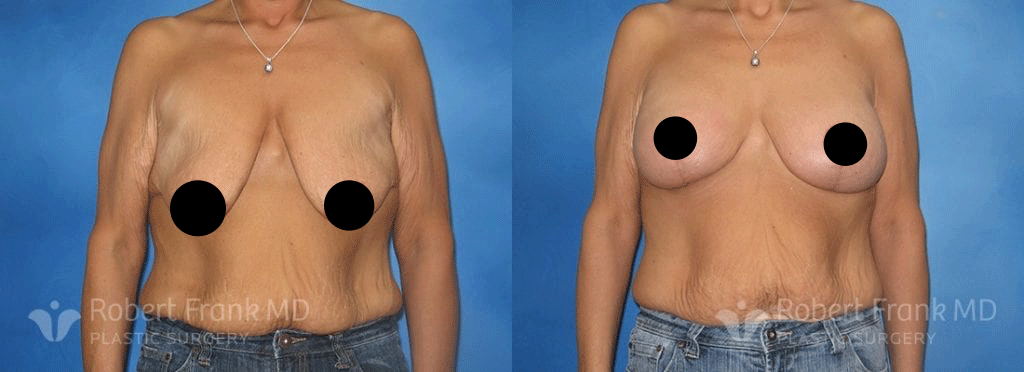
Robert Frank, MD Plastic Surgery helps women achieve a more symmetrical and youthful appearance through breast lift.* Dr. Frank offers years of experience performing the surgery and is the holder of a federal patent for periareolar mastopexy, which focuses on reducing the appearance of scars in the final results. He is proud to serve the Munster, Hobart, Crown Point, and Frankfort communities.
Typically, Dr. Frank recommends the surgery for women who:
- Have always had drooping breasts and are seeking improvement.
- Following weight change or childbirth, want to improve their breasts and the position of their nipples.
While augmentation focuses on adding volume, breast lift helps patients from Munster, Hobart, Crown Point, and Frankfort improve the aesthetics of their breasts, restore youthfulness, and create balance without the use of an implant.*
Dr. Frank’s Approach to Breast Lift
During the initial consultation, Dr. Frank describes the breast lift procedure and answers any questions patients have about surgery and outcomes. He prioritizes patient education and safety, which gives those in his care confidence in his recommendations.
Through these discussions, patients get to know Dr. Frank and receive guidance in their decision to have plastic surgery. Our practice also provides a price quote for everything excluding postoperative medications. Following a second visit, preoperative testing and exams, and scheduling, patients are ready for surgery.

*Individual results may vary
View the Breast Lift Gallery
About the Procedure
Dr. Frank conducts breast lift surgery for patients in a state health department accredited facility. Patients receive general anesthesia to keep them comfortable through the procedure.
Surgeons can perform a breast lift using several different approaches. Basically the more “lift” they need, the more skin needs to be removed and consequently the more incisions are needed. Before surgery, Dr. Frank advises patients about the technique he will use based on his experience and on the results they want to achieve.
As an example, a periareolar mastopexy employs a single incision around the areola. Dr. Frank’s patented implantable prosthesis takes the pressure off the skin edge, reducing the appearance of scars and creating a more reliable outcome.* This approach is recommended for patients with limited droop, while women with significant needs may require other techniques. Often options include a vertical mastopexy in which the scar is “lollipop” shaped or a wise pattern lift which is similar in scarring to a breast reduction surgery.
Dr. Frank sometimes combines a breast lift with augmentation (use of an implant) to achieve the symmetry and fullness his patients want. This procedure is sometimes done simultaneously and sometimes stagered (the lift first followed by the implant at a later date). Our practice is happy to discuss options with patients before they make their decision.
Recovery from Breast Lift
Most breast lift patients tell us that pain is bearable .* The breast is usually not very tender, and so incisions cause less discomfort. Most women are back to work within a week.*
Typically, Dr. Frank advises patients to avoid activities that cause the breasts to bounce—including running and heavy exercise—for up to two months. Limiting these activities can help patients reduce scarring and create the youthful and attractive results they want to achieve.*
Dr. Frank’s Advice on Recovery
We all have our own ideas of how long recovery should take. Unfortunately, this means many patients try to rush their recovery and go back to normal activities. This trend is especially true among young mothers who want to spend every moment with their children. They may attempt to play with or pick up their children before their bodies are ready to handle that strain.
Dr. Frank sees rushed recoveries in several ways, with one of the most common being pain. Patients who try to be too active too early in the recovery process often find themselves running through their pain medication too soon and have to ask for an early refill. Rather than increase the amount of medication you take, you will feel better sooner and end the period wherein you need the medication faster if you allow your body to rest. Do not force your body to undergo more physical strain than it is ready to handle. It is okay to take 30-minute breaks on the couch.
Another way Dr. Frank sees patients push themselves too hard is an increased risk of both swelling and dangerous hematomas.
For example, after liposuction, your body needs time to move fluid out of your skin. Patients who have had liposuction will have skin that feels firmer than untreated areas because of this fluid buildup. Getting that fluid out of your skin is one of your recovery goals during the weeks after surgery. But if you activate your muscles near the treated area, that activity draws fluid into the area, which increases swelling and often pain. In the case of a tummy tuck, too much activity early in your recovery can increase blood pressure, which then causes more oozing into the space created during surgery. While a little fluid is normal, it’s easy to overwhelm your body’s ability to absorb this fluid. A hematoma is the result.
To minimize these concerns, Dr. Frank encourages all patients to clear their schedules of everything except the most essential duties for the two weeks after surgery. You should minimize the amount of childcare, job responsibilities, meetings, social activities, and home chores in which you partake so your body can rest. You will feel better and recover faster if you plan ahead so that your body, not your calendar, determines when you are ready for your physical activities.
Contact Us Today
Robert Frank, MD provides breast lifts in Hobart and Munster, which also allows patients from Crown Point, IN and Frankfort, IL to improve their appearance. Talk with Dr. Frank about breast lift for improving the position and appearance of your breasts and nipples. Schedule a consultation online or by calling (219) 513-2011.
*Individual results may vary